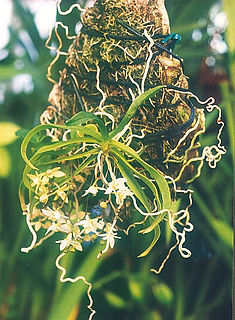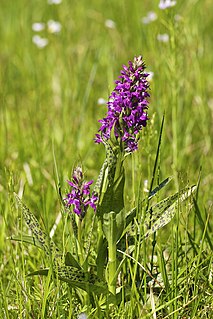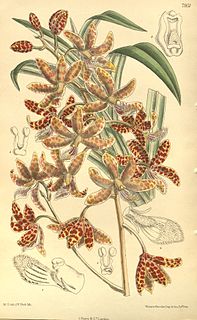
Thrixspermum, commonly known as hairseeds or 白点兰属 , is a genus of flowering plants in the family Orchidaceae. Orchids in this genus are epiphytes, lithophytes or terrestrial plants with flat, leathery leaves and short-lived flowers with the sepals and petals more or less similar to each other. The labellum is rigidly fixed to the column and has three lobes. The side lobes are erect and the middle lobe is thick and fleshy. There are about 190 species distributed from tropical and subtropical Asia to the Western Pacific. Most species grow in lowland or tropical rainforests up to an altitude of 1,200 m.

Dactylorhiza majalis is a terrestrial Eurasian orchid.

Dipodium, commonly known as hyacinth orchids, is a genus of about forty species of orchids native to tropical, subtropical and temperate regions of south-east Asia, New Guinea, the Pacific Islands and Australia. It includes both terrestrial and climbing species, some with leaves and some leafless, but all with large, often colourful flowers on tall flowering stems. It is the only genus of its alliance, Dipodium.

Dipodium elegantulum, commonly known as the elegant hyacinth orchid, is a leafless orchid that is endemic to Queensland. In spring and summer it has up to sixty pale to dark pink flowers with a few darker spots and streaks near the tips, on a tall flowering stem.

Dipodium roseum, commonly known as rosy hyacinth-orchid or pink hyacinth-orchid, is a leafless saprophytic orchid found in east and south-eastern Australia. In summer it produces a tall flowering stem with up to fifty pale pink flowers with small, dark red spots. A widespread and common species it is often confused with D. punctatum but has darker, less heavily spotted flowers.
Tuberolabium is a genus of epiphytic flowering plants from the orchid family, Orchidaceae. It is native to the Old World Tropics, including Assam, Indochina, Taiwan, Indonesia, New Guinea, Philippines, Queensland, the Cook Islands and Micronesia. Of the 18 known species, 7 are endemic to the Indonesian island of Sulawesi.

Dipodium variegatum, commonly known as the slender hyacinth-orchid, or blotched hyacinth-orchid, is a leafless mycoheterotrophic orchid that is endemic to south-eastern Australia. It forms mycorrhizal relationships with fungi of the genus Russula.
Dipodium campanulatum, commonly known as the bell-flower hyacinth orchid, is a leafless mycoheterotroph orchid that is endemic to south-eastern Australia. In summer it has up to thirty five white flowers with large, dark red spots and blotches.

Dipodium stenocheilum, commonly known as tropical hyacinth-orchid, is a leafless saprophytic orchid that is endemic to northern Australia. For most of the year the plant is dormant but in summer it produces a tall flowering stem with up to twenty five white flowers with purple spots and a mauve labellum.
Dipodium brevilabium is an orchid species that is endemic to Western Papua in Indonesia. The species was formally described in 2009.
Dipodium parviflorum is an orchid species that is native to Peninsular Malaysia and Sumatra in Indonesia. The species was formally described in 1911 by Dutch botanist Johannes Jacobus Smith.

Dipodium ensifolium, commonly known as leafy hyacinth-orchid, is an orchid species that is endemic to north-east Queensland. It has sword-shaped leaves and up to twenty pink to mauve flowers with purplish spots and blotches.

Dipodium pictum, commonly known as brittle climbing-orchid or climbing hyacinth-orchid, is an orchid species that is native to Malesia and the Cape York Peninsula in Australia.
Dipodium elegans is an orchid species that is native to Sumatra in Indonesia. The species was formally described in 1900 by Dutch botanist Johannes Jacobus Smith.

Dipodium paludosum is an terrestrial orchid species that is native to south-east Asia. It occurs in Cambodia, Thailand, Vietnam, The Philippines, Sumatra, Peninsular Malaysia and Borneo. The leaves up to 30 cm long and 2.5 cm wide. The axillary racemes comprise 6 to 12 fleshy flowers which are each up to 4 cm wide and are cream with purple-magenta spots.
Dipodium pulchellum is an almost leafless orchid that is endemic to north-east New South Wales and south-east Queensland in Australia. Up to forty pink flowers with darker blotches are borne in summer and winter on flowering spikes up to 90 cm (40 in) long.
Dipodium scandens is an orchid species that is native to Malesia.
Dipodium squamatum is a mycoheterotrophicorchid species of the tribe Cymbidieae.

Trachoma, commonly known as spectral orchids, is a genus of flowering plants in the family Orchidaceae. Orchids in this genus are epiphytic plants with leafy stems, crowded, leathery leaves arranged in two ranks and a large number of relatively small, short-lived flowers that often open in successive clusters. The sepals and petals are free from and more or less similar to each other, except that the petals are often smaller. The labellum is rigidly fixed to the column and is more or less sac-shaped. There are about 17 species distributed from Assam to the Western Pacific Ocean. Most species grow in rainforests, often on emergent trees such as hoop pine.













